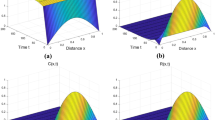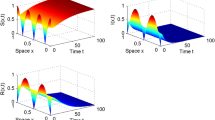Abstract
This paper considers two differential infectivity (DI) epidemic models with a nonlinear incidence rate and constant or varying population size. The models exhibits two equilibria, namely: a disease-free equilibrium O and a unique endemic equilibrium. If the basic reproductive number σ is below unity, O is globally stable and the disease always dies out. If σ>1, O is unstable and the sufficient conditions for global stability of endemic equilibrium are derived. Moreover, when σ>1, the local or global asymptotical stability of endemic equilibrium for DI model with constant population size in n-dimensional or two-dimensional space is obtained.
Similar content being viewed by others
References
Chen Lansun, Chen Jian. Nonlinear Biological Dynamical Systems Beijing: Science Press (in Chinese), 1993.
Anderson RM, May RM. Infectious Diseases of Human: Dynamics and Control, Oxford: Oxford University Press, 1992.
Moghadas SM. Two core group models for sexual transmission of disease, Ecological Modelling, 2002, 148(1):15–26.
Castillo-Chavez C, Cooke K, Huang W, et al. On the role of long incubation periods in the dynamics of AIDS, J Math Biol, 1989, 27:373–398.
Hyman JM, Li J. An inituitive formulation for the reproductive number for the spread of diseases in heterogeneous population, Math Biosci, 2002, 167:65–86.
Hyman JM, Li J, Stanley EA. The differential infectivity and staged progression models for the transmission of HIV, Math Biosci, 1999, 155:77–109.
Vargas C, Esteva L. Analysis of a dengue disease transmission model, Math Biosci, 1998, 150:131–151.
Ma Z, Liu J, Li J. Stability analysis for differential infectivity epidemic models, Nonlinear Analysis: Real world Application, 2003, 4:841–856.
Castillo-Chavez C, Huang W, Li J. Competitive exclusion in gonorrhea models and other sexually transmitted disease, SIAM J Appl Math, 1996, 56:494–508.
Castillo-Chavez C, Huang W, Li J. Competitive exclusion, and coexistence of multiple strains in an SIS STD model, SIAM J Appl Math, 1999, 59:1790–1811.
Moreira HN, Wang Y. Global stability of an S→I→R→I model, SIAM Rev, 1997, 39(3):496–502.
Zhang Xinan, Chen Lansun. The periodic solution of a class of epidemic models, Computers and Mathematics with Applications 1999, 38(3–4):61–71.
Liu W, Hethcote, HW, Levin SA. Dynamical behavior of epidemiological models with nonlinear incidence rates, J Math Biol, 1987, 25:359–380.
Liao Xiaoxin. Theory Methods and Application of Stability, Wuhan: Huazhong Science and Engineering University Press, (in Chinese), 1999.
Chen Junjie, Zhang Nansong. An HIV/AIDS transmission model with infectious stages and constant recruitment, Acta Math Appl Sinica-Chinese series, 2002, 25(3):538–546.
Author information
Authors and Affiliations
Additional information
Supported by the Science Foundation of the Education Department of Zhejiang Province.
Rights and permissions
About this article
Cite this article
Junjie, C. Two differential infectivity epidemic models with nonlinear incidence rate. Appl. Math. Chin. Univ. 20, 305–315 (2005). https://doi.org/10.1007/s11766-005-0006-8
Received:
Revised:
Issue Date:
DOI: https://doi.org/10.1007/s11766-005-0006-8




